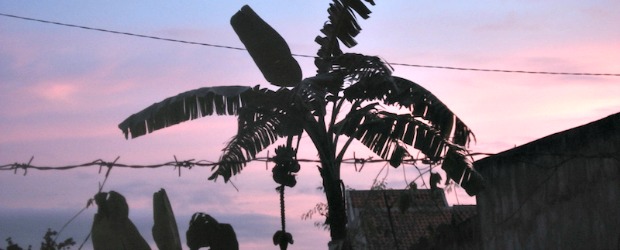You have no items in your cart. Want to get some nice things?
Go shopping

Last night I dreamed of living dead people. I suppose the correct term would be zombies, though I don’t exactly know what constitutes a zombie. I’m not a big zombie movie fan, but I’ve seen 28 Days Later and The Walking Dead where modern day zombies are far less lethargic than their earlier counterparts. They’re swift little bastards, the new generation.
It was more a nightmare than a dream since you don’t really have dreams—nice dreams—about living dead people. My zombies were kind of stilted and faceless, though I was too busy running away from them to get a good look. They chased me slow and drunk-like, the way old-school zombies did, and as in most horror movies, I moved slow and drunk-like too, just one beat ahead of them. It had a happy ending, my nightmare, after I hid behind the thin walls of my childhood bedroom. Evidently, zombies aren’t too smart as I could have found me, but I guess the living dead are noted more for their clumsy bloodlust than their keen tracking abilities. “Happy ending” is perhaps a misnomer, as I don’t think dreams or nightmares have endings. They are more like soundless, jerky newsreels on a continuous loop, interrupted only when you wake.
The worst kind of nightmare is followed by a hangover of sorts. Details like names or faces are long forgotten, but the essence of the dream—that pooling sense of dread or loss—hovers like fog throughout the day. When this nightmare woke me before dawn, I considered turning on all the lights and then felt ashamed as a 42-year old woman dreaming about monsters. Besides, I know now what I did not know as a child: when darkness settles in, it is always better to close your eyes with your face to the wall than lie awake, waiting for the monsters to come.
The zombie dream struck me as odd because you’d think I’d have nightmares about the usual stuff: cancer, student loan debt, car accidents, unemployment —or even tsunamis. Tsunamis were foremost in my mind when I lived in Sumatra, Indonesia seven years ago. My husband had accepted a yearlong teaching job at a university in the city of Padang, which was less than a mile from the western coast. After the devastating impact of the 2006 tsunami in northern Sumatera’s Aceh, geologists predicted the next big one would strike and roll across the city in a muddy black stew of coconut trees, metal, concrete, and people. “You’re in the red zone,” my Indonesian friend earnestly reminded me one day. “Make sure you find a high tree.”
Yet it wasn’t tsunamis that frightened me (I had staked out my high tree within the first week); it was terrorists. The U.S. Embassy’s travel advisories for Indonesia were frequent and disarmingly blunt, especially since the Bali bombing in 2002, which claimed over 200 lives. Along with suicide bombings, we were also warned of being targeted individually for shootings or kidnappings. The embassy urged us to be alert, avoid expatriate hangouts, and to vary our daily route, which was surprisingly harder than you’d think. This had less to do with thrill-seeking genes than the impossibility of preparing for a terrorist attack as a civilian. After all, there are only so many ways you can enter and exit your home, particularly when it sits at the end of a one-lane street and you are one of only two Westerners in the entire city. Large crowds in marketplaces could be avoided for a day or two until the necessity of food won out, and then I’d set out to shop at Padang’s labyrinthine central market. Of course, anonymity wasn’t an option. No matter how far into the maze I went, I couldn’t escape the feeling of a having a giant ‘You Are Here’ target on my back.
An American friend working in Jakarta once remarked that the thing that irked him most about dying from a terrorist attack was that it was so impersonal. “I mean they don’t even know me, which kind of pisses me off.” We both laughed at the absurdity of the statement, even though it made perfect sense to me. There was something vaguely insulting about being murdered by someone who hadn’t met you first. Someone who hadn’t shared a drink with you or listened to your thoughts on global warming—who hadn’t realized how special you were.
Two months after we arrived in Sumatra, three suicide bombers blew themselves up along a busy stretch of restaurants in Bali. With a death toll of twenty, this bombing was smaller than the one in 2002. Local newspapers dubbed it Bali Bombing II to distinguish it from the first. I understood the need for quick newspaper references, but there was something strange about making it sound like a movie sequel. Indonesian newspapers make you realize U.S. ones are heavily sanitized before they go to print—that someone carefully excises any violent deaths or body parts from the photo with their delete key. This doesn’t happen in Indonesia. Plane crashes, car accidents, suicide bombings—editors in Indonesia pull no punches. Following Bali Bombing II, The Jakarta Post published photographs of the three bombers’ heads, with hopes of identifying them. The heads were remarkably flawless, something I never knew about suicide bombers: while the torso is obliterated, the head and legs often remain perfectly intact upon detonation. A CCTV camera later revealed grainy footage of one of the bombers entering a restaurant seconds before blowing it up. Without context, there is nothing foreboding or sinister about it; it is just a solitary boy with a backpack walking into a restaurant.

Of course I stared at the photographs for a while; I couldn’t look away. The thing that struck me most was not just how young, but how dead they looked. Again, this sounds really stupid, but if you’ve ever studied a dead person’s face, you’ll know what I mean. I’m not religious, but looking at the bombers’ blank faces made me question whether there is some form of immaterial life force that is extinguished at death—a soul? —because something was missing. At the most, two looked sleepy and one, gently surprised. Propped up unceremoniously on a table, the facial expressions didn’t show any trace of malice, rage, conviction, or whatever it is that compels a young man to murder so many in such a violent, methodical way. The bombers’ heads were empty and slightly collapsed, like post-Halloween pumpkins left on a porch.
I hadn’t studied a photograph with that same intensity since I was seven years old. It too was a photograph of a dead man, a black and white picture of a black man chained to a tree. Because he was dead, pitched forward and straining against the tree, chains had embedded in his flesh. The caption below the photo said the man had been tortured with a blowtorch and murdered by the KKK. Their photo was on the opposite page, the KKK, men dressed in bleached moon robes and tall hats that pointed to the sky. It was a rainy Sunday afternoon so while my sister made her toy horse race and leap over imaginary jumps, my mother tried to explain the picture to me—the dead black man and the tall white ghosts. I had just started Sunday school and evil was more fantastical than ordinary. These were just pictures of ordinary men. So I just stared at the photo and thought about who held the blowtorch and who fastened the chains and who watched.
In the week following Bali bombing II, I steered clear of open markets, beachfront restaurants, and large crowds. Essentially, I stayed home for five days, only venturing out to buy fruit and goat satay from the local sellers nearby. I didn’t feel any safer, though; if anything I felt more conspicuous being the only western woman in the neighborhood buying fruit and goat satay. Padang, like many Indonesian cities, is more a collective village than a city and Sumatrans’ kindness could only be surpassed by their curiosity. It was not unusual for me to be ogled intensely by taxi drivers, food vendors, housewives, teenage girls, college students, toddlers, and cigarette hawkers on my way to get laundry detergent at the corner store. Forget about keeping a low profile. In Padang, I was practically a movie star.
Within two weeks, life went back to a semblance of normal, particularly after I ran out of necessities like toilet paper and decent chocolate, and had to venture out to one of the large grocery stores. And though cautious, my husband and I remained happily in Indonesia for the duration of his two-year contract. The three suicide bombers were eventually identified and linked to Indonesia’s Al-Qaeda terrorist organization, Jemaah Islamiah, the same group behind the 2003 Marriott hotel car bombing that killed 12 people and injured 150 in Indonesia’s capital city of Jakarta. When, during our stay, the U.S. State Department booked us into the Jakarta Marriott hotel for a teachers’ conference, I questioned their logic. My nerves were quelled, however, once I saw the long row of x-ray scanners and newly crafted concrete bunkers for thorough vehicle inspections. I won’t go so far as to say that having guards snake long mirrors beneath your vehicle for a bomb is a good feeling, just so long as they are looking beneath everyone else’s vehicle. Although our stay was blissfully uneventful, it turned out that all the scanners and vehicle inspections were for naught. Three years later, in 2009, two suicide bombers blew themselves up in the lobbies of both the Jakarta Marriott and neighboring Ritz Carlton hotel. Apparently, the bombers had bypassed all the security by checking into hotel rooms and assembling their bombs. Eight people were killed in this attack.
I now live in Abu Dhabi, the glittery capital city of the United Arab Emirates, where the wealth is both ridiculous and beguiling. A strange by-product of living amidst such affluence are those moments—however fleeting—when I can almost taste the deluded insularity of being rich, even though we are not wealthy, ourselves. Because life in this sunbaked country is lived indoors more than half the year due to the sweltering heat, an inordinate focus is placed on what happens between the walls of luxury. On weekends, I float from malls with marble fountains to gilded hotel lobbies that serve gold-flecked teacakes.
The problem with living amidst such opulence—besides developing a vitamin D deficiency from lack of sunlight—is the false sense of security it gives you. Bad things happen to good people, but for some reason it is harder for me to reconcile bad things happening to posh, shiny places bathed in sunlight. And sometimes, it is almost enough to make me forget about those sleepy, empty heads and re-embrace my childhood belief in monsters.
But I know better. Of course, I do. There are no monsters—only ordinary men with chains, only boys with backpacks. Had I looked closer at last night’s zombies, had I not been so intent on escaping, I’d have noticed they weren’t zombies at all. I recall last night’s pursuit, only this time I turn to look at my attackers. My body turns slow and dumb towards something the mind cannot accept and I see them: boys, shuffling towards me, their arms outstretched. Their bodies are torn and shattered, but their faces are pristine as snow. Each of them bears the remains of a backpack, of duct tape, and electrical wiring. And I watch—I can’t look away—as they mouth wordlessly, “It’s nothing personal.”

About Heather Corrigan
Heather is a writer living in Vermillion, South Dakota. Originally from Connecticut, she has published essays in Ascent, North American Review, Lowestoft Chronicle, Connecticut Review, Oyez Review, and Louisville Review, among others. Her most recent essay, Widmarked, was a finalist in the Southeast Review 2015 Narrative nonfiction contest. She can be reached at https://heathercorrigan.wordpress.com or @HeatherCorrigan




Wow. Forgot where I was reading this (posh bar in sleepy Leamington Spa…not quite Jakarta). Gripping thank you.
Gemma
Thanks, Gemma! (a posh bar doesn’t sound half bad either…) :)